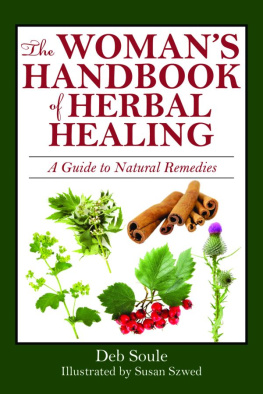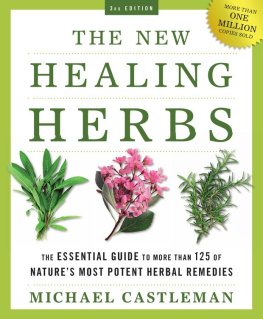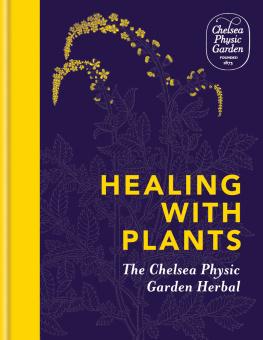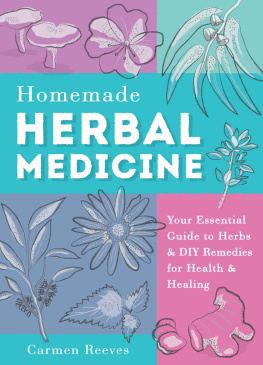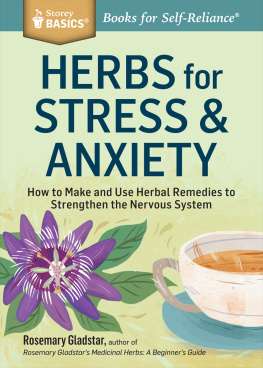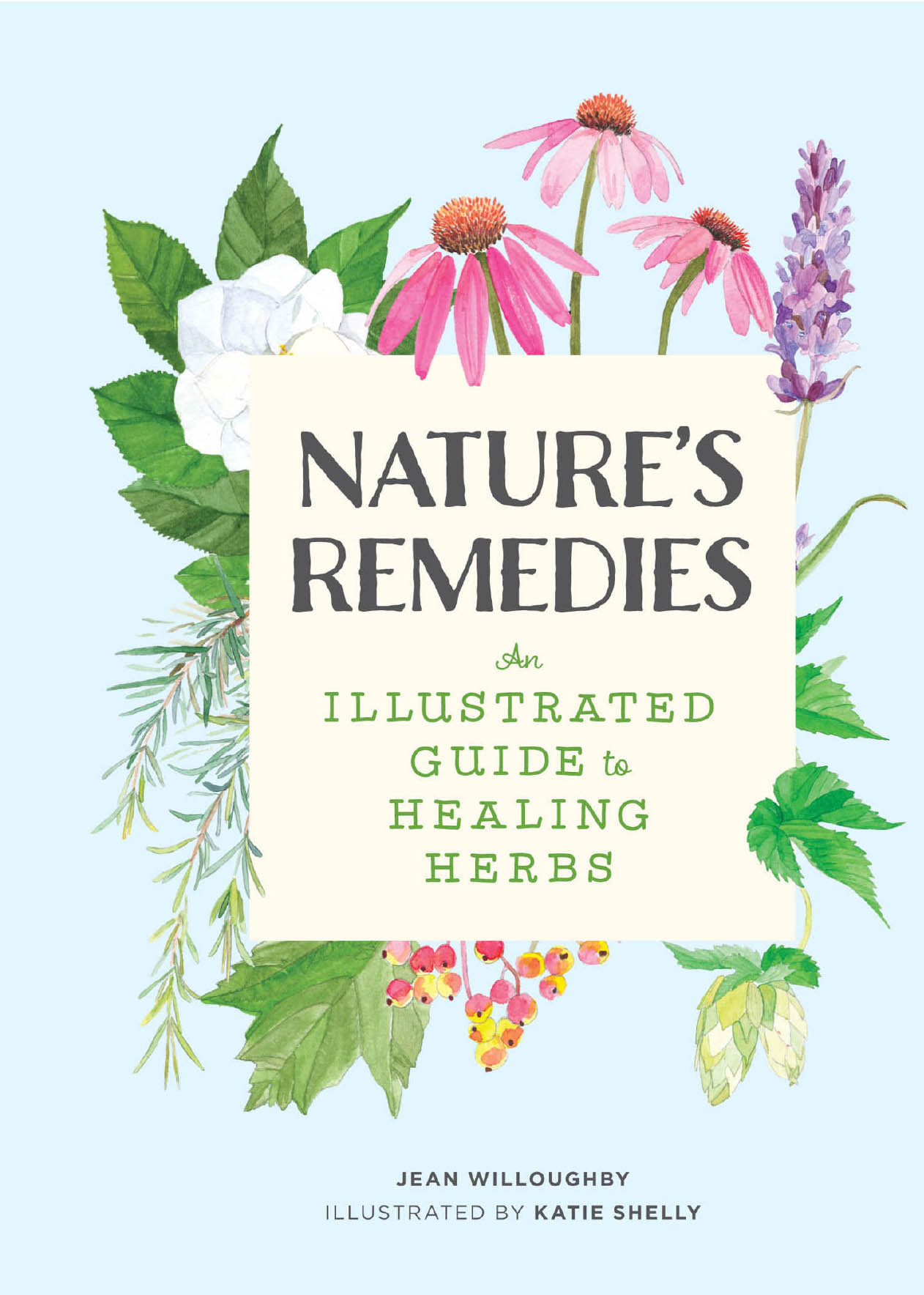

Text copyright 2016 by Jean Willoughby.
Illustrations copyright 2016 by Katie Shelly.
All rights reserved. No part of this book may be reproduced in any form without written permission from the publisher.
Library of Congress Cataloging-in-Publication Data:
Names: Willoughby, Jean, author.
Title: Natures remedies : an illustrated guide to healing herbs / Jean Willoughby ; illustrated by Katie Shelly.
Description: San Francisco : Chronicle Books, 2016. | Includes index.
Identifiers: LCCN 2016018842 | ISBN 9781452156026 (hc) | ISBN 9781452159027 (epub, mobi)
Subjects: LCSH: HerbsTherapeutic use. | Medicinal plants. | Alternative medicine. | BISAC: HEALTH & FITNESS / Herbal Medications. | MEDICAL / Alternative Medicine.
Classification: LCC RM666.H33 W55 2016 | DDC 615.3/21dc23 LC record available at https://lccn.loc.gov/2016018842
Design by Tandem Books
The information in this book should not be used as a substitute for medical advice and is not suggested as treatment for any condition that might require medical attention. Consult your doctor or a licensed health-care professional regarding your needs. The author and Chronicle Books hereby disclaim any and all liability resulting from injuries or damage caused by any recommendations contained in this book.
Chronicle Books LLC
680 Second Street
San Francisco, California 94107
www.chroniclebooks.com
Contents
Spotlight Herb:
Withania for Enhanced Energy
Spotlight Herbs:
Peppermint & Nettle for Cold Relief
Spotlight Herb:
Milk Thistle for Liver Health
Spotlight Herb:
Holy Basil for Stress Relief
Spotlight Herb:
Raspberry Leaf for Sexual Health
Spotlight Herb:
Gotu Kola for Nervous System Health
Spotlight Herb:
Turmeric for Inflammation
Spotlight Herb:
Calendula for Healthy Skin
Spotlight Herb:
German Chamomile for Restful Sleep
INTRODUCTION
Herbs delight our senses. If youve ever enjoyed a soothing cup of herbal tea or a well-seasoned meal, then youve already experienced a little of what herbs have to offer. Herbs add fragrance and flavor to foods and drinks like nothing else, but they are also powerfully effective in promoting health and well-being.
A medicinal herb is any plant that can be used to heal or nourish. Worldwide there are an estimated eighty thousand species of edible plants known to provide some aspect of this practical value. For this book, I selected more than sixty of the most well-known and effective medicinal herbs, most of which have played a vital role in the practice of traditional herbal medicine throughout history.
These easy-to-use herbs work exceptionally well for dozens of common ailments. Colds, stomach upsets, sleeplessness, fatigue, the winter blues, headachesthese happen to all of us at some point. Learning about herbs can empower you with safe, natural ways to remedy these troubles while also improving your overall health. In this guide, you will learn about practical ways to use herbs in everyday life and gain a foundation of knowledge that will enable you to continue your exploration. You will read about the most widely recognized benefits of each herb and learn fascinating facts about how herbs work, how they are prepared, and the history of herbs as healing aids.
Herbs have beneficial properties and health- enhancing effects thanks to the impressive variety of nutrients and phytochemicals (chemicals naturally produced by plants) they contain. Peppermint, for example, contains the organic compound menthol, which produces a cooling sensationcontributing to an anti-inflammatory responsewhen it comes into contact with skin receptors in the mouth (as when we are drinking peppermint tea) or on our hands (as when applying a salve). Herbs are often categorized based upon these actions or properties and their affinities for healing and soothing certain areas of the body, such as the skin, sinuses, or digestive system.
To better understand the healing power of herbs, consider the heartiness of plants. Plants cant pull up their roots and leave when times get tough. They have to react and adapt to their surroundings. Plants survive and thrive thanks to an array of chemical compounds that they produce, many of which function to help protect them from environmental stress. Its thought that consuming many of the same compounds that fortify plants in turn enhances our own health.
Equal parts art and science, herbal medicine seeks to address the underlying factors that contribute to health and illness. In doing so, it aspires to improve our overall quality of life. As we all know, enhancing our health is not limited to treating everyday ailments or concerns. While herbs can no doubt serve as remarkably effective remedies for particular ailments, the goal of herbal medicine is broader: to promote robust health and radiant well-being. By learning about herbsthe vast majority of which are safe, affordable, accessible, and effectivewe become better able to take care of each other and ourselves and attain a more resilient state of health.
Its no wonder that so many herbs have been thought of as gifts from the gods in cultures around the world. Herbs offer us not only trusted remedies, but also enjoyment as sources of beauty, pleasure, and creative fulfillment. After reading this book, you may even be inspired to grow a few of these little gifts of the earth at home. Wherever your desire to learn takes you, I hope you venture onward with excitement about herbs and how they can enrich your life.
A SHORT HISTORY OF HERBS
Herbs have been utilized and celebrated by almost every culture around the world. Their role in food and medicine is deeply rooted throughout human history. Archaeological studies suggest that herbs were consumed by our Paleolithic ancestors more than fifty thousand years ago. The earliest written works on plants and their use in medicine come from the ancient Sumerians and Egyptians, who began making lists of ailments and herbal remedies as early as 1700 B.C.E. Sumerian pharmacists wrote their herbal prescriptions in cuneiforman ancient system of writingon clay tablets. Egyptian medical papyri document dozens of herbs and their uses that are familiar to us today, such as aloe vera for soothing the skin, licorice root for coughs, and garlic and onions to help prevent colds.
In many parts of the world, indigenous and traditional knowledge of plants has been transformed into highly developed systems of medicine. In China, the use of herbs in healing goes back as early as the Shang dynasty, which arose in the sixteenth century B.C.E. In India, the Ayurvedic tradition reaches back more than three thousand years. In early texts from both traditions, we find catalogs of herbs and their uses along with intriguing philosophical ideas and doctrines about the nature of health and healing. Throughout the Americas and Africa, people developed rich and complex relationships with plants used in healing and spiritual practices, the knowledge of which was largely passed on through oral tradition and apprenticeships.
In the fifth century B.C.E., the healing properties of plants were promoted by the legendary Greek physician Hippocrates, regarded as the father of Western medicine for his enduring contributions to the study of health and illness. His teachings are expressed in the Hippocratic Corpus, a collection of some sixty tracts on the practice of medicine, attributed largely to his students. The
Next page


